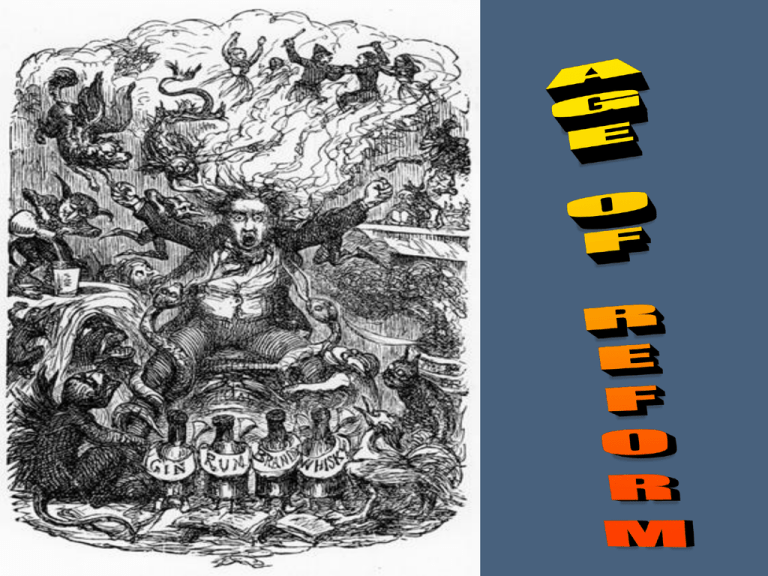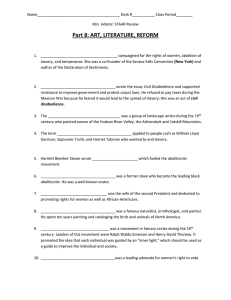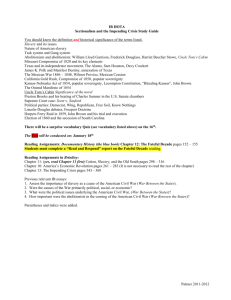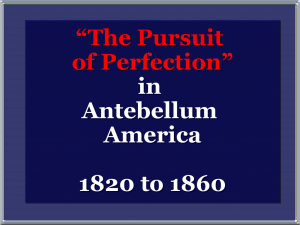“social conscience” for improving the quality of life in society
advertisement

•Reformers sought to purify the nation by removing sins of slavery, intemperance (alcohol), male domination and war….. •Reformers used education, lyceum meetings, newspapers in inform public of their issues….. •Reformers questioned the value of material progress in an age of industrialization if it were not accompanied by progress in solving the important human problems •Primarily a Northern movement •Southerners resisted reform movements because it feared abolition of slavery • Some removed themselves from society and tried to create Utopian societies based on collective ownership (socialism/communism) Purifying the Nation • Reformers pointed out the inequality in society stating the DOI as the basis of their argument… • Out of the Great Awakening, people wanted to reform society. •They developed a “social conscience” for improving the quality of life in society Temperance Movement • The most significant reform movements of the period sought not to withdraw from society but to change it directly • Temperance Movement — undertook to eliminate social problems by curbing drinking – Led largely by clergy, the movement at first focused on drunkenness and did not oppose moderate drinking – In 1826 the American Temperance Society was founded, taking voluntary abstinence as its goal. •Lyman Beecher •Neal Dow •Lucretia Mott •Anti-Alcohol movement •American Temperance Society formed at Boston-----1826 • sign pledges, pamphlets, anti-alcohol tract 10 nights in a Barroom and What I Saw There •“Demon Drink” •stressed temperance and individual will to resist The Temperance Movement • During the next decade approximately 5000 local temperance societies were founded • As the movement gained momentum, annual per capita consumption of alcohol dropped sharply The Drunkard’s Progress From the first glass to the grave, 1846 The Asylum Movement (orphanages, jails, hospitals) • Asylums isolated and separated the criminal, the insane, the ill, and the dependent from outside society • “Rehabilitation” – The goal of care in asylums, which had focused on confinement, shifted to the reform of personal character The Asylum Movement • Dorothea Dix, a Boston schoolteacher, took the lead in advocating state supported asylums for the mentally ill • She attracted much attention to the movement by her report detailing the horrors to which the mentally ill were subjected – being chained, kept in cages and closets, and beaten with rods • In response to her efforts, 28 states maintained mental institutions by 1860 Growth of slavery Growth of slavery Abolitionist Movement 1816 --> American Colonization Society created (gradual, voluntary emancipation) Wanted to create a free slave state in Liberia, West Africa. Abolitionism • William Lloyd Garrison, publisher of the The Liberator, first appeared in 1831 and sent shock waves across the entire country – He repudiated gradual emancipation and embraced immediate end to slavery at once – He advocated racial equality and argued that slaveholders should not be compensated for freeing slaves. The Liberator Premiere issue January 1, 1831 Abolitionism • Free blacks, such as Frederick Douglass, who had escaped from slavery in Maryland, also joined the abolitionist movement • To abolitionists, slavery was a moral, not an economic question • But most of all, abolitionists denounced slavery as contrary to Christian teaching • 1845 --> The Narrative of the Life Of Frederick Douglass • 1847 --> “The North Star” Anti-Slavery Alphabet The Tree of Slavery—Loaded with the Sum of All Villanies! Black Abolitionists David Walker (1785-1830) 1829 --> Appeal to the Colored Citizens of the World Fight for freedom rather than wait to be set free by whites. Sojourner Truth (1787-1883) or Isabella Baumfree 1850 --> The Narrative of Sojourner Truth R2-10 The Underground Railroad “Conductor” ==== leader of the escape “Passengers” ==== escaping slaves “Tracks” ==== routes “Trains” ==== farm wagons transporting the escaping slaves “Depots” ==== safe houses to rest/sleep Abolitionist Movement Abolitionism forced the churches to face the question of slavery head-on, and in the 1840s the Methodist and Baptist churches each split into northern and southern organizations over the issue of slavery Even the abolitionists themselves splintered Gradualists Immediatists More conservative reformers wanted to work within established institutions, using churches and political action to end slavery •Gag rule was passed in Congress which nothing concerning slavery could be discussed. •Under the gag rule, anti-slavery petitions were not read on the floor of Congress •The rule was renewed in each Congress between 1837 and 1839. •In 1840 the House passed an even stricter rule, which refused to accept all anti-slavery petition. On December 3, 1844, the gag rule was repealed





